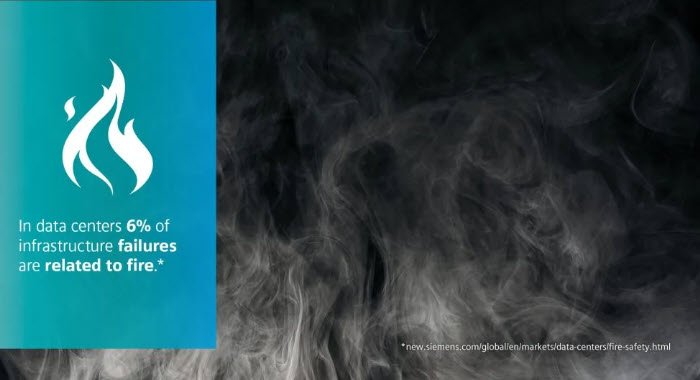Preventative Technical Fire Safety in Data Centers
Republished from Siemens blog
The primary task of technical equipment in data centers is to ensure maximum availability of data. Fire safety plays a major role in this context. The figures cited in the manual “Designing and Operating IT Rooms and Data Centers” [1] are eye-opening: If a company’s data center is destroyed by fire, the very existence of the business is at stake. 70 percent of all affected businesses are forced to shut down. Only 23 percent are fully operational again after one year. Minimizing the risk of fire damage is therefore a top priority. Early detection of incipient fires and swift initiation of countermeasures are critical basic requirements for maximum system availability.
Preventive fire protection
Fire is the most frequent cause of downtime in data centers. Smoldering fires in cabling are just one source. When it comes to the reliable operation of data centers, the main safety goal is to detect a fire as early as possible and extinguish it. As early as possible means before a substantial percentage of hardware sustains damage. For this reason, the primary focus is on technical fire protection.
Reliable early fire detection through aspirating smoke detectors (ASD)
An effective protection concept must first guarantee reliable fire detection. Data centers, however, have specific needs that push standard smoke detectors to their limits. The rooms are very large and sealed off, and ventilation systems circulate a high volume of air. Aspirating smoke detectors (ASDs) meet the complex requirements of such an environment. They continuously sample air through a network of pipes and route it into a measurement chamber where it is analyzed for smoke particles. This allows detection of even the slightest amount of fire gases. Inside the measurement chamber, the aspirating smoke detectors detect the size and concentration of particles. To this end, they use optical dual-wavelength detection, i.e. two wavelengths of light – blue and infrared. Unlike conventional aspirating smoke detectors, dual-wavelength technologies are able to precisely differentiate between smoke and deceptive phenomena. This ensures deception-proof fire detection at the earliest outbreak stage.
Effective extinguishing
Once the detectors have detected a fire, an extinguishing system is automatically triggered. For optimal protection, two things are important: the method of releasing the extinguishing agent and the selection of the most suitable agent. Because of the sensitive IT infrastructure, water is a poor choice for data centers. A gas extinguishing system is a far better alternative. In the event of an alarm, it floods the affected area with a gaseous extinguishing agent that is released through nozzles. This agent also extinguishes covered or hidden fire sources by suppressing the amount of oxygen the fire needs. Possible choices include inert gases or chemical extinguishing agents. Although gas extinguishing systems are the best choice for protecting data centers, they do harbor one risk: hard disks may experience problems after the extinguishing system has been triggered. These issues range from automatic shutdown of a hard disk without damage after a restart to serious malfunctions. Studies have shown that the main cause of such problems is the relatively high noise level generated by a conventional gas extinguishing system during flooding. That is why Siemens has developed the Sinorix Silent Extinguishing solution with its patented Silent Nozzle. This nozzle allows for comparatively quiet yet effective extinguishing in data centers and server rooms.
Coordinated protection
A comprehensive fire safety system requires perfect coordination between fire detection, extinguishing system activation and alarming. Ideally, the fire protection system is integrated into an overall solution that enables professional control and transparent management of the complex workflows and processes inherent in the infrastructure of a data center. Here is an example to illustrate the benefits in day-to-day operations: Increased power consumption detected through energy monitoring can be an early indicator of a problem that could cause a fire. Once such a situation is detected, countermeasures can be taken quickly before even greater damage occurs.

